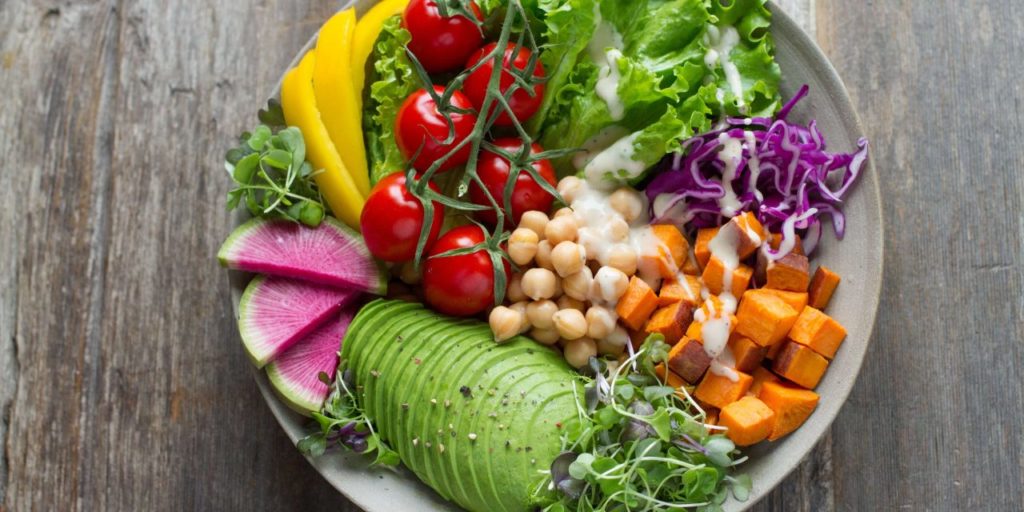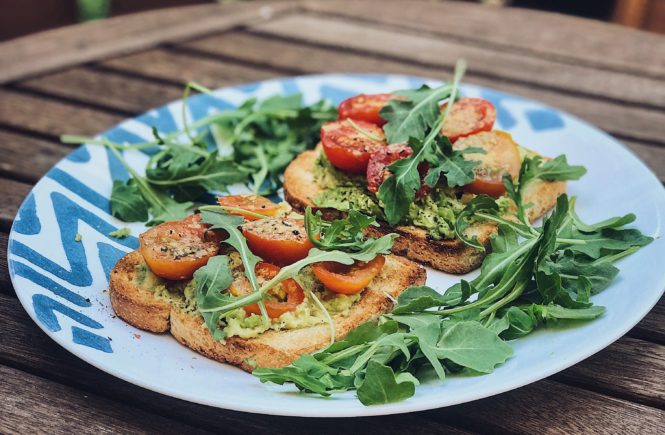When it comes to staying on track with your wellness goals, diet obviously plays a huge role. What we put in is what we get out. And quite frankly, if we eat shit, we will feel like (yup, you guessed it) shit!
One of the tips mentioned in 10 Tips For A Healthier Kitchen is to try to keep your fridge and pantry stocked with healthy, whole-food options. This way, there is really no excuse to snack on junk food.
Let’s say you know full well that potato chips are your weakness. Seriously, you always demolish the whole bag. (Hey, it ain’t hard to do). You’re more likely to snack on celery and carrot sticks with hummus than potato chips if you keep the chips out of the house (or towards the back of the pantry and out of sight) and keep the prepped veggies and hummus front and center in your fridge!
Keeping some of your produce prepped in the fridge makes it a lot more convenient too, because let’s be honest, who wants to wash and chop up veggies when you’re hangry? No thanks.
On that note, here are some of my top healthy kitchen staples that I try to never run out of. Keeping these items on hand in the kitchen makes it easier to prepare healthy, plant-based meals and snacks and helps me stay on track.

1.) Raw Veggies
Baby carrots, celery, cucumber slices, cherry/grape tomatoes, jicama sticks, etc. These are all great veggies to keep on hand because they are easy to prep, portable, and filled with fiber so they’re filling. Plus they’re great for dipping in hummus and guacamole.
2.) Frozen Veggies
Frozen goods are great because they last a long time so you can stock up on your favorites. I love Costco’s giant bags of frozen veggies and fruit. When you’re in a pinch, you can just toss a bag of frozen broccoli in a steamer basket, or a bag of frozen brussels sprouts in your air fryer (you do have an air fryer, right!?).
3.) Apples
Apples are my go-to fruit. In my opinion, they’re the perfect food. They’re delicious, full of flavor and fiber, super filling, portable, easy to find at any store, and healthy AF. “An apple a day” am I right? I always have apples in my fridge and when there’s a sale on organic Honeycrisps, best believe one of my produce drawers is completely filled with them.
4.) Lemons
I use lemons every single day, starting with my lemon water in the morning. They’re packed with vitamin C and help to cleanse our liver. A true superfood! Lemons are useful on their own, in recipes, and even can be used to make all-natural household cleaning products. They’re a definite staple in my house.
5.) Frozen Bananas
Good ol’ bananas. A vegan’s best friend. These bad boys might just be the most versatile fruit there is. Plus, they’re dirt cheap. I use at least one frozen banana a day to make my smoothie, but you can also use them to make delicious vegan ice cream. DO NOT throw away your spotty bananas! Slice those suckers up and freeze them for later! You’ll be glad you did.
6.) Coconut Water
I’ll be the first to admit that I’m a total coconut water snob. I have been drinking Harmless Harvest forever and pretty much won’t settle for anything less (yup, I’m a brat). Since I’m active and live in an extremely hot and humid climate, coconut water is more of a necessity than a luxury. An amazing source of electrolytes and potassium, it keeps me hydrated after strenuous workouts and heated yoga classes. As a bonus, it adds some extra sweetness to your post-workout smoothie.
7.) Sprouted Rice/Lentils/Beans
The difference between sprouted and un-sprouteded rice, lentils and beans is that the un-sprouted versions are much harder to digest. I usually buy regular lentils, beans, grains, and nuts and soak them myself. Soaking removes enzyme inhibitors and makes the grain, bean, legume or nut easier to break down. However, soaking or sprouting takes a while, and if your meal isn’t planned in advance, you won’t have the soaked version available. This is why I like to buy pre-sprouted lentils and beans to keep in my pantry for instances when I’m not able to pre-soak or sprout ahead of time. They cost much more than regular ones though, so from a financial standpoint, it’s best to soak them yourself and save the pre-sprouted for “emergencies.”
8.) Gluten-Free Bread
Sometimes you just need a sandwich. But that doesn’t have to mean falling off the wagon! There are tons of amazing gluten-free (even grain-free!) bread options out there. Just make sure you read the ingredients carefully to ensure they are clean and plant-based. Since I don’t use bread daily, I keep mine in the freezer so it lasts.
9.) Coconut Aminos
Coconut aminos have my heart. Is that a weird proclamation? They’re just the best. They add flavor to pretty much anything I’m cooking in a pan and usually eliminate the need for oil (which I typically try to avoid in my cooking) when sautéing. Coconut aminos are very slightly sweet but not “coconut”, are soy-free, and only contain 90 mg of sodium per serving as opposed to regular soy sauce that contains up to 900 mg! They are an awesome alternative to soy sauce (which contains wheat and soy that is likely GMO).
10.) Garlic
Pretty sure garlic can make even the most bland of meals taste good. I always keep it on hand to add to soups, sauces, sauté with veggies, or just add flavor to a boring meal (which hopefully doesn’t happen often, ha). I always have garlic powder in my spice cabinet, too for a more convenient option.
11.) Gluten-Free Pasta
When all else fails, make pasta. I usually have a variety of different bean, lentil, and grain-based pastas in my pantry. My favorites are Trader Joe’s Red Lentil Penne, Black Bean Rotini, and Yellow Lentil & Brown Rice Spaghetti. After a long day and no dinner plans set in place, I usually just whip up some black bean or red lentil pasta, toss with sautéed veggies and red sauce, and call it a night!
12.) Pink Salt, Herbs & Spices
Most of us know that tons of sodium in our diet is unhealthy. But that doesn’t mean we need to avoid it altogether (unless specifically instructed to do so by your doctor). Use salt sparingly and if you’re going to use it, try to choose either Pink Himalayan Rock Salt, or Celtic Sea Salt. These versions contain more trace minerals and health benefits. My spice cabinet holds an abundance of Ayurveda-approved spices and dried herbs like turmeric, cumin, coriander, fennel, rosemary, basil, ceylon cinnamon, and more. You can even start a mini herb garden on a windowsill and grow your own fresh herbs. Spices and herbs are a healthy and easy way to add vibrant color and flavor to any meal.
I want to know, what are YOUR favorite convenient ways to keep your kitchen healthy? Share your tips in the the comments below!




